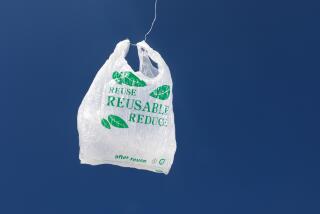Let’s Get to the Bottom of Paper Bags
- Share via
It is time to consider the paper bag. The brown ordinary one you take your groceries home in. If you think those glossy designer types with paper cord handles are paper bags or those white ones with oranges, flowers or balloons printed on them or those packages of brown paper bags for children’s lunches for sale in stores, go away; they are true decadence, symbols of how prosperity, luxury and status have poisoned our pioneer blood.
But I do not mean to go into the social significance of the paper bag. Let us leave that for another time and turn our attention solely to the grocery brown paper bag, particularly and specifically to the bottoms.
The bottoms of brown paper bags--what? You ask how I come to address such a subject, indeed all the odd, far-flung fringes of life I write on from time to time? Mon dieu, is it possible they all originate in my brain? Well, yes it is. Except now and then a stringer (I like to call them that, it fits so well with fringes, don’t you think?), one of my stringers will, so to speak, call an unraveled thread to my attention.
Margaret Fay, my South Pasadena stringer, did so the other evening, arriving at my house with handfuls of brown paper bags as well as her usual overbrimming store of political-preservation news. “Look,” she said, “did you ever read the bottoms of paper bags?” In truth I had not. I put the thought aside for future consideration along with the paper bags.
Not a week later my New York stringer, Iris Bell, sent her intermittent surprise package of clippings, textures, odds and ends. (It is not altogether easy to explain Iris Bell’s wide-ranging interests. Suffice it to say that she raises (lovingly) liverworts and tells me “my moss is still growing well on my book shelves.”) Accompanying an article on cherry blossom picnics at the Ninnaji Temple, an assortment of all but edible handsome handmade Italian, French and Japanese papers and an “especially iridescent” paper clip, was a small brown snippet--”great fibers in this paper bag.” And there were. And I realized al instante that the time had come to discuss them, at least their bottoms. (One cannot cover the whole gestalt of paper bags in one article.)
Take your brown paper bags and look at their bottoms. These things are actually made by people apparently. Here, from Von’s, is a Trojan Kraft, No. 770 paper bag red-inked “Made by William J.” Here is a Townsend No. 12 bearing, also in red, on its bottom, “Krafted by Steve Mack.” A small bag, a No. 6 with no name but a pine tree symbol is stamped LOWERY. From Safeway, I have a GP 1210A Manufactured by David L. Morford.
Now we come to what seems to be a higher level--Princeton paper bags. They are dated and all bear the slogan, “With Pride From the Best People.” They are not crafted or krafted, but are Personally Inspected. Here is a No. 420, Nov. 14, 1985, Personally Inspected by Vidal. An earlier No. 8 (Sept. 10, 1985) has been Personally Inspected by Renaldo Brown. Larger, but earlier (July 10, 1985) is a No. 735, Personally Inspected by Carlos Muett. Another 420, vintage Oct. 23, 1985, is PI’d by Robert D’Arbelles. The heavy 800s, elegant bags are from elegant Bristol Farms (printed in green rather than red--green artichokes, checkerboard, diamonds). I have two from Dec. 23, ‘85, both PI’d by Jim Wallace. And the latest, Jan. 20, 1986, PI’d by Stephanie.
Just Stephanie, no last name. This is disappointing, very disappointing. All these years of feminist struggle and Stephanie is just Stephanie, one of the girls. For heaven’s sake, Stephanie, start 1986 out right. Pick up the torch and that rubber stamp and put your last name on it.
And, if you’re one of us, you’ll put your own last name and not your husband’s.
More to Read
Eat your way across L.A.
Get our weekly Tasting Notes newsletter for reviews, news and more.
You may occasionally receive promotional content from the Los Angeles Times.










